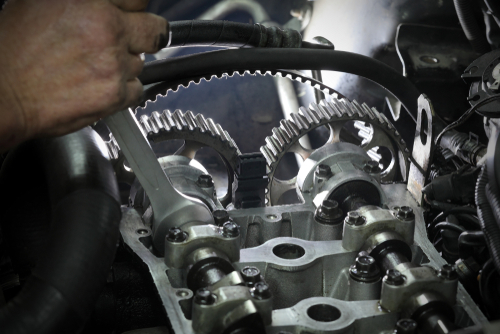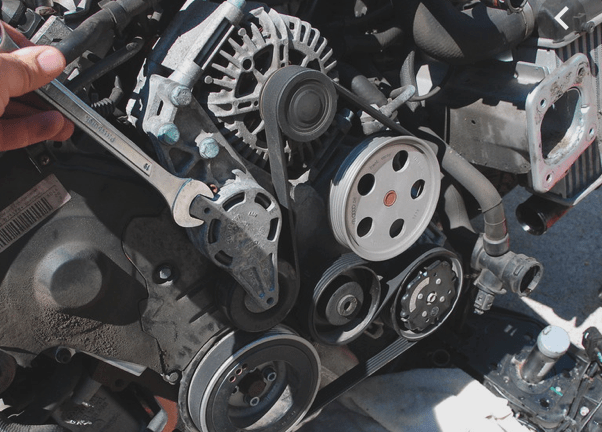Is your check engine light glaring at you like an angry traffic cop?
If you’re seeing the P0014 code pop up, don’t panic!
You’re about to become an expert on this pesky little problem.

P0014 indicates that your camshaft timing is off its rocker – specifically, it’s over-advanced on Bank 1.
In simpler terms, your engine’s timing is a bit too eager, like a hyperactive kid who’s had one too many sodas.
This issue can affect your car’s performance, fuel economy, and even emissions.
But fear not! With a little know-how and some elbow grease, you’ll be back on the road in no time.
Let’s dive into the world of camshafts, timing, and why your engine control module is throwing a fit.
Key Takeaways
- P0014 indicates over-advanced camshaft timing on Bank 1
- Common causes include low oil pressure, faulty VVT solenoids, or worn timing components
- Proper diagnosis and timely repair can prevent more serious engine damage
Exploring Code P0014
Code P0014 indicates your engine’s camshaft timing is off. This pesky problem can affect your car’s performance and fuel economy if left unchecked.
Anatomy of Code P0014
P0014 is a diagnostic trouble code that points to issues with the “B” camshaft position.
The “B” typically refers to the exhaust camshaft on Bank 1 of your engine.
When your car’s computer detects that the camshaft timing is too far advanced, it triggers this code.
Think of it as your engine’s way of saying, “Hey, my timing’s off!”
The code specifically relates to the variable valve timing (VVT) system. This clever bit of engineering allows your engine to adjust valve timing for better performance and efficiency. When it goes wonky, P0014 pops up.
Symptoms of Code P0014

You might notice your car acting a bit odd when P0014 is present. Here are some telltale signs:
- Check Engine Light illuminated (obviously!)
- Rough idling or stalling
- Poor fuel economy (your wallet won’t be happy)
- Reduced engine performance (goodbye, zoom-zoom)
- Difficulty starting the engine
These symptoms occur because the camshaft timing is over-advanced, causing the valves to open and close at the wrong times.
It’s like a dance where one partner is always a step ahead – not very graceful!
In severe cases, you might hear a rattling noise from the engine. That’s never a good sound, folks.
If you notice these symptoms, it’s time to get your trusty steed to a mechanic pronto!
The Nitty-Gritty of Camshafts and Timing

Buckle up, gear heads! We’re about to dive into the heart of your engine’s rhythm section.
Camshafts and timing are like the drummers of your car’s band, keeping everything in sync.
Camshaft Timing Essentials
Ever wondered why your engine purrs like a kitten? It’s all thanks to camshaft timing.
This magical dance between your camshaft and crankshaft ensures your valves open and close at just the right moment.
Think of it as a well-choreographed ballet.
Your camshaft, the prima ballerina, twirls gracefully atop your engine. Its lobes push down on the valves, letting fuel in and exhaust out.
But here’s the kicker: timing is everything!
If your camshaft gets ahead of itself (we call that being “over-advanced”), your engine might start coughing and sputtering like it’s got a bad case of the flu.
Your timing chain or belt is the unsung hero here. It keeps your camshaft and crankshaft in perfect harmony.
But like an old rubber band, it can stretch over time. When that happens, you might see that pesky P0014 code pop up on your dashboard.
VVT and Its Role
Now, let’s talk about the cool kid on the block: Variable Valve Timing (VVT).
It’s like giving your engine a cup of coffee – it perks things up when you need more pep in your step.
VVT allows your engine to adjust its valve timing on the fly.
Need more power for passing that slow-moving truck? VVT’s got your back. Want better fuel economy for your long road trip? VVT can help with that too.
The star of the VVT show is the camshaft phaser.
This nifty device can advance or retard your camshaft timing faster than you can say “P0014”.
But when it goes wonky, that’s when you might see our troublesome friend P0014 rear its ugly head.
Remember, keeping your oil clean and at the right level is crucial for VVT.
It’s like giving your engine a spa day – it keeps everything running smoothly and helps prevent those annoying check engine lights.
Common Culprits Behind P0014

When your engine throws a P0014 code, it’s like your car is telling you its timing is off. Several culprits could be behind this automotive hiccup.
Slinky Solenoids and Sensors
Your camshaft position sensor might be playing hide and seek with accurate readings. This sneaky little device can cause all sorts of timing troubles if it’s not doing its job.
The oil control solenoid, on the other hand, could be stuck in party mode, allowing too much oil flow to the camshaft actuator.
When this happens, your camshaft thinks it’s time to boogie when it should be taking it slow.
Don’t forget about the actuator itself. If it’s worn out, it might be slacking on the job, unable to adjust the camshaft timing properly.
The Oil Factor
Your engine oil is like the lifeblood of your car, and when it comes to P0014, it’s often the prime suspect.
Oil viscosity that’s thicker than molasses in January can slow down the camshaft’s moves.
On the flip side, if your oil’s thinner than your aunt’s coffee, it might not provide enough pressure to keep things in check.
Low oil pressure can leave your camshaft high and dry, unable to adjust its timing.
Check your oil level and quality regularly. A clogged oil filter can also throw a wrench in the works, restricting oil flow when your engine needs it most.
Wiring Woes
Sometimes, the problem isn’t mechanical but electrical. Faulty wiring can cause miscommunication between your car’s brain and its moving parts.
Corroded or loose connections can make your camshaft position sensor send mixed signals.
It’s like trying to have a phone conversation in a tunnel – the message just doesn’t get through clearly.
Short circuits can also cause havoc, making your car’s computer think the camshaft is doing the cha-cha when it’s actually standing still.
Don’t underestimate the power of a good electrical check-up.
The Usual Suspects
Beyond the specifics, there are a few more general troublemakers to consider.
Worn camshaft lobes can throw off timing like a broken metronome.
A stretched timing chain is another potential culprit. It’s like trying to keep time with a rubber band – not very precise.
Lastly, don’t rule out a faulty variable valve timing (VVT) system. This high-tech gizmo can cause all sorts of timing troubles if it decides to go rogue.
Diagnosing and Troubleshooting
So, you’ve got a P0014 code lighting up your dashboard like a Christmas tree. Don’t panic!
Let’s dive into how you can diagnose this pesky camshaft timing issue and get your ride purring again.
Gathering the Tools and Data
First things first, you’ll need to arm yourself with the right tools.
A trusty OBD-II scanner is your new best friend. This little gadget will help you retrieve the P0014 trouble code and any accompanying freeze frame data.
Don’t forget to grab your vehicle’s repair manual – it’s like a treasure map for your engine.
Next, take a peek under the hood.
Check for any obvious signs of wear or damage to the timing belt, chain, or VVT solenoid. Your ears can be useful too – listen for any unusual rattling or ticking sounds that might indicate a timing issue.
Dealer Tech vs. DIY
Now, you might be wondering if you should tackle this yourself or leave it to the pros.
If you’re handy with a wrench and have some automotive know-how, diagnosing P0014 can be a DIY project.
You’ll need to inspect the camshaft position sensors, wiring, and connectors for any signs of damage or corrosion.
For the more adventurous, you can check the engine oil level and condition. Low or dirty oil can wreak havoc on your VVT system.
If you’re feeling less confident, there’s no shame in taking it to a dealer tech.
They have fancy diagnostic tools and the expertise to pinpoint tricky electrical issues or problems with the PCM or ECM.
Remember, sometimes it’s better to leave it to the pros than to turn your engine into an expensive paperweight!
Car Brands and P0014
The P0014 code crosses brand boundaries, affecting a range of popular automakers. You’ll find this pesky problem popping up in everything from economical compacts to luxury sedans.
The Hydra of Hyundai and P0014
Hyundai owners, you’re not alone in the P0014 predicament.
This code often rears its head in models like the Sonata and Santa Fe.
Your Hyundai’s variable valve timing (VVT) system might be the culprit.
It’s like a finicky orchestra conductor, sometimes getting the timing all wrong.
Common causes include:
- Oil contamination
- Faulty oil control valves
- Stretched timing chains
Don’t panic!
A trip to your friendly Hyundai dealer or a savvy independent mechanic can often sort this out.
Sometimes, a simple oil change with the correct viscosity oil can work wonders.
Chevrolet’s Choreography with Camshafts
Chevy fans, your bowtie beauties aren’t immune to the P0014 tango.
Models like the Malibu and Cruze have been known to trip the light fantastic with this code.
Your Chevy’s camshaft position sensor might be out of step.
It’s like a dance partner who can’t quite find the rhythm.
Potential fixes include:
- Replacing the camshaft actuator
- Cleaning or replacing the VVT solenoid
- Addressing oil pressure issues
Remember, regular oil changes are like dance lessons for your engine – they keep everything moving smoothly.
Toyota, Timing and Tribulations
Toyota owners, even your famously reliable rides can fall victim to P0014.
The Camry and RAV4 have been known to join this unwelcome party.
Your Toyota’s VVT system might be struggling to keep time.
It’s like a metronome that’s lost its beat.
Common issues include:
- Clogged oil passages
- Worn camshaft gears
- Faulty oil control valves
Don’t worry, your trusty Toyota isn’t down for the count.
A trip to the dealership or a Toyota specialist can often set things right.
Honda’s Harmonization with Cam Control
Honda aficionados, your VTEC engines aren’t immune to P0014 discord.
The Accord and Civic have been known to hit a sour note with this code.
Your Honda’s i-VTEC system might be out of tune.
It’s like a guitarist who can’t quite nail that tricky chord change.
Potential solutions include:
- Replacing the VTC actuator
- Addressing oil pressure problems
- Updating the engine control module software
Remember, using the correct oil viscosity is like choosing the right strings for your guitar – it keeps everything in harmony.
Acura’s Acquaintance with Advanced Timing
Acura owners, your luxury rides can also fall prey to P0014 problems.
Models like the TLX and MDX have been known to experience this timing hiccup.
Your Acura’s Variable Cylinder Management (VCM) system might be the troublemaker.
It’s like a conductor who can’t decide which section of the orchestra should play.
Common fixes include:
- Replacing the VTC solenoid
- Addressing oil consumption issues
- Updating the powertrain control module
Don’t fret – your Acura’s precision engineering can often be brought back into perfect time with the right touch.
Audi’s Affinity for Accurate Actuation
Audi enthusiasts, even your finely-tuned German engineering can stumble with P0014.
The A4 and Q5 have been known to set off this timing alarm.
Your Audi’s Audi Valvelift System might be the source of the problem.
It’s like a Swiss watch with a grain of sand in the gears.
Potential remedies include:
- Replacing the camshaft adjuster
- Addressing timing chain stretch
- Updating the engine control unit software
Remember, using Audi-approved oil is like using the right fuel for your rocket – it keeps everything running at peak performance.
Frequently Asked Questions
Dealing with a P0014 code can be tricky, but don’t worry – we’ve got your back.
Let’s dive into some common questions about this pesky issue that’s messing with your ride’s groove.
What do I need to check first if my car shows an ‘over-advanced camshaft position timing’… before I bust out my wallet?
Before you start throwing money at the problem, grab your trusty OBD-II scanner and double-check that code.
Next, pop the hood and give your engine a once-over. Look for loose connections, frayed wires, or any signs of oil leaks around the camshaft area.
Don’t forget to check your oil level and quality.
Dirty or low oil can wreak havoc on your camshaft timing. If everything looks ship-shape, it might be time to consult your car’s manual or a pro.
Is it a DIY weekend job to fix an ‘exhaust camshaft position timing over-advanced Bank 1’, or should I just hand it to the pros?
Well, that depends on your mechanical skills and how much you enjoy spending your weekends covered in engine grease.
If you’re handy with a wrench and have some experience, you might be able to tackle simpler causes like replacing a faulty camshaft position sensor or cleaning a clogged VVT solenoid.
But if the thought of messing with your engine’s timing makes you break out in a cold sweat, it’s probably best to leave it to the pros.
They’ve got the tools and know-how to diagnose and fix the issue without accidentally turning your engine into a very expensive paperweight.
Why do I feel like déjà vu when that pesky P0014 code pops up again after I just cleared it?
Ah, the return of the prodigal code.
If your P0014 keeps coming back like a bad penny, it’s likely because you’ve only treated the symptom, not the cause.
Clearing the code without fixing the underlying issue is like putting a Band-Aid on a leaky pipe – it might look better for a minute, but the problem’s still there.
This persistent little bugger usually means there’s a more serious issue lurking in your engine.
It could be a worn camshaft, a failing VVT system, or even a problem with your engine’s timing chain. Time to dig deeper or get a pro involved.
Could fixing a camshaft position timing really dig a hole in my pocket, and how do I know I’m not getting taken for a ride with the repair cost?
Brace yourself – fixing camshaft timing issues can indeed leave your wallet feeling a bit lighter.
The cost can vary widely depending on the root cause and your car’s make and model.
Simple fixes like replacing a sensor might only set you back a couple hundred bucks, but if you’re looking at a timing chain replacement, you could be talking four figures.
To avoid getting fleeced, get multiple quotes from reputable shops.
Don’t be shy about asking for a breakdown of parts and labor costs. And remember, sometimes paying a bit more for quality work can save you money in the long run.
Does driving with a code P0014 make my car a ticking time bomb, or is it just an excuse to visit my in-laws by bus?
While it might be tempting to use this as an excuse to skip the in-laws’ potluck, driving with a P0014 code isn’t something to take lightly.
It’s not quite a ticking time bomb, but it’s definitely a ticking… something.
Ignoring this issue can lead to reduced fuel efficiency, poor engine performance, and in worst-case scenarios, engine damage.
So while your car probably won’t explode, it’s best to address the problem sooner rather than later. Your engine (and your wallet) will thank you.
What’s the magic behind ‘B’ camshaft position timing and how does it throw my vehicle’s groove off?
The ‘B’ in P0014 refers to the exhaust camshaft, which is like the conductor of your engine’s exhaust valve symphony.
When it’s timed perfectly, your engine purrs like a kitten. But when it’s off, well, things get a bit chaotic.
An over-advanced timing means the exhaust valves are opening too early. This can lead to a loss of engine power, reduced fuel efficiency, and in some cases, a rougher idle than a teething toddler.
It’s all about precision in the engine world, and even small timing issues can throw your whole ride off its groove.
